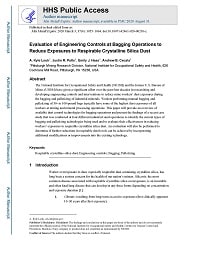Mining Publication: Evaluation of Engineering Controls at Bagging Operations to Reduce Exposures to Respirable Crystalline Silica Dust
Original creation date: March 2020
Authors: A Louk, J Patts, E Haas, A Cecala
The National Institute for Occupational Safety and Health (NIOSH) and the former U.S. Bureau of Mines (USBM) have given a significant effort over the past four decades in researching and developing engineering controls and interventions to reduce mine workers’ dust exposures during the bagging and palletizing of industrial minerals. Workers performing manual bagging and palletizing of 50- to 100-pound bags typically have some of the highest dust exposures of all workers at mining and mineral processing operations. This paper will provide an overview of available dust control technologies for bagging operations and present the findings of a recent case study that was conducted at four different industrial sand operations to identify the current types of bagging and palletizing technologies being used and to evaluate their effectiveness in reducing workers’ exposures to respirable crystalline silica dust. An evaluation will also be performed to determine if further reductions in respirable dust levels can be achieved by incorporating additional modifications or improvements into the existing technology.

- Analysis of the Silica Percent in Airborne Respirable Mine Dust Samples from U.S. Operations
- Bag and Belt Cleaner Reduces Employee Dust Exposure
- Control of Respirable Dust
- The Effects of Low Quartz Mass Loading and Spatial Variability on the Quartz Analysis of Surface Coal Mine Dust Samples
- Improving Silica Dust Control Through Targeted Research
- Improving the Performance of Fan-Powered Dust Collectors in Stone-Cutting Applications
- Infographics: Helping Mines Control Respirable Silica Dust
- Laboratory Evaluation of a Canopy Air Curtain for Controlling Occupational Exposures of Roof Bolters
- Methods to Lower the Dust Exposure of Bag Machine Operators and Bag Stackers
- Reducing Enclosed Cab Drill Operator's Respirable Dust Exposure at Surface Coal Operation With a Retrofitted Filtration and Pressurization System